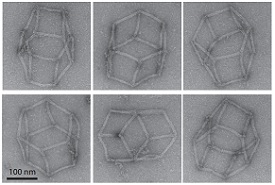 |
| DNA polyhedrons made using the process of DNA origami and imaged using DNA-PAINT--Courtesy of Harvard |
Researchers at Harvard's Wyss Institute have developed self-assembling, three-dimensional cages made from DNA that could someday be used to deliver drugs.
Using a method called "DNA origami," the scientists connect strands of DNA using aspects of their code, ultimately creating a specific shape that can be controlled or manipulated depending on the need. The process itself originally came about at the Wyss Institute under scientist William Shih, and Peng Yin was the lead author of the paper published in the journal Science.
One of the first shapes the researchers made resembled a tripod; two of these tripods could conceivably be connected end to end to make a polyhedron shape, according to a report from Harvard. These self-assembling cages were 60 times larger than the DNA building blocks and 400 times larger than the individual DNA bricks.
The proteins could eventually be modified to include proteins for targeted delivery or gold nanoparticles for imaging purposes.
The team also took sharp 3-D snapshots of the nanocages, the first ever of single DNA structures. They used a DNA-based microscopy method called DNA-PAINT, which creates blinking images based on sequences in the DNA itself.
"Bioengineers interested in advancing the field of nanotechnology need to devise manufacturing methods that build sturdy components in a highly robust manner, and develop self-assembly methods that enable formation of nanoscale devices with defined structures and functions," Wyss Institute Director Don Ingber said in a statement. "Peng's DNA cages and his methods for visualizing the process in solution represent major advances along this path."
- here's the Harvard report
- and here's the Science abstract